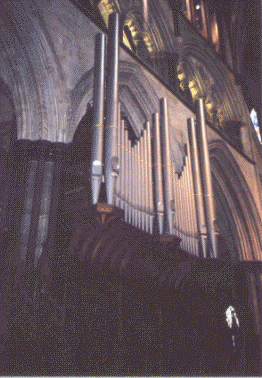Visit to
 |
As our coach neared We
disembarked at |
The
Kenneth Jones organ is a two-manual and pedal instrument
with an 8ft and 4ft stop in each unenclosed department,
all housed in an impressive oak case and fitted with the
now de rigueur straight pedalboard and tracker
action. Robert Fielding played the Bach Trio Sonata 1v
in E minor, which ideally demonstrated the delicate
voicing and character of this organ. Robert confessed to
some trepidation, playing a Trio Sonata for an audience
of organists but, of course, his performance was
faultless.
There was
just time before lunch for some members to view the
practice room Vincent Woodstock organ of 2001. This was
also a two-manual and pedal instrument with tracker
action, which felt like silk, but with no independent
pedal stop just a pedal coupler. Interestingly, an octave
of flute basses were housed, for compactness, suspended
from the inside roof of the organ’s case.
The Rt.
Hon. Sir Edward Heath, who lives in the Cathedral Close
and is an honorary member of the KCOA, joined us for
lunch in the college refectory. He still radiates a Prime
Ministerial presence and great charm although he is now
in his eighty-seventh year. His face is marked and worn
like a piece of old linoleum, his eyes as watery and
mournful as an elderly bulldog’s, but with an inner
sparkle as he spoke of his organ scholar days at Balliol
College Oxford and the variety of music and musicians at
Salisbury. His sparkle only wavered briefly, his lips
puckering like someone sucking unexpectedly on a piece of
lemon, when mention was made of the Salisbury Cathedral
girls choir who were to be singing for us later in the
day. No, it was the boys’ choir for Sir Edward.
Politics
was only briefly mentioned when one of our members piped
up, “I voted for you in 1970, and in 1973”. He
beamed. Undoubtedly, he has excelled in many fields, but
politics was his first love.
It had
been a privilege and honour for us to meet with Sir
Edward, but time prevented us staying longer as we were
soon due at
This fine
church features in Simon Jenkins’ –
Alan
Harwood, the Director of Music at
The
present 2-manual organ was originally built by Hill in
1869 and then moved by them to a new loft on the north
side of the chancel in 1898. It was restored by
Hill, Norman and Beard in 1994, and in 2002 a Bass Flute
8ft, Principal 8ft and a wooden Trombone 16ft were added
to the pedal department by Nicholsons. These new
stops are controlled by pedal hitchdowns so that the
appearance of the 1898 console is preserved. Andrew
demonstrated the full range of the organ by playing
Whitlock – Elegy from the Symphony in G minor
arr. Malcolm Riley, and Flor Peeters –
Chorale and Toccata from the Suite Modale. There
are 24 speaking stops, with mechanical action to the
manuals and stop controls, and direct electric action to
the pedals. The sound of this fine organ is very
full and colourful, and it was interesting to hear how
tonal characteristics had changed between the Green of
1792 and this Hill of 1869.
The
Cathedral and Close were breathtakingly lovely in the
evening light — this could be nowhere but
 |
The famous Willis organ of 1876
came into its own in a splendidly articulated
performance of Bach’s Fantasia and Fugue
in G minor, which although excitingly played
with registration changes, including the full
reeds, never lost clarity. After
Evensong Simon Lole spoke about the organ (4
manuals and 65 speaking stops) which has been
little altered tonally. Indeed, the
pipework was carefully guarded by Sir Walter
Alcock, Organist from 1916 until his death in
1947, and no alterations were permitted. Willis
carried out restoration work in 1934 and 1969,
with new action and updating by Harrison and
Harrison in 1978. A
number of members took advantage of the
opportunity to play the organ, which sounds
magnificent throughout the Cathedral. Others
enjoyed walking round the building in the soft
evening light, perhaps noticing the striking dark
colours of the Lady Chapel Prisoners of
Conscience window designed by Gabriel Loire and
installed in 1980, or the Snetzler chamber organ
of 1764 acquired by the Cathedral in 1958, with
elegant casework designed by Lord Mottistone in
1961. |
So another splendid day arranged by our President Andrew Cesana, came to an end. Our heartfelt thanks are due to him for providing us with full specifications and histories of all the organs we saw and for all the research and detailed arrangements he had made for a day which gave so much interest and enjoyment.